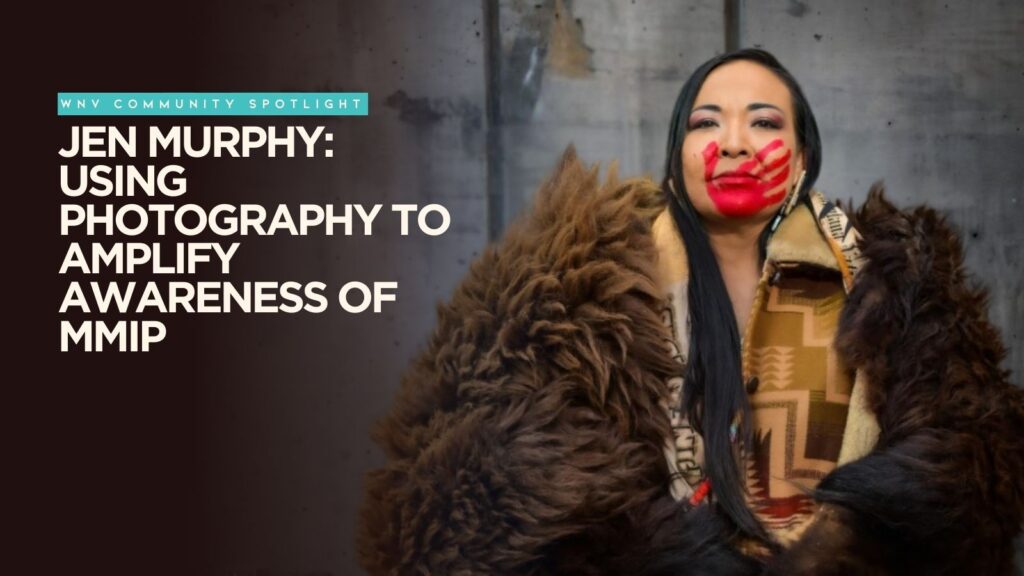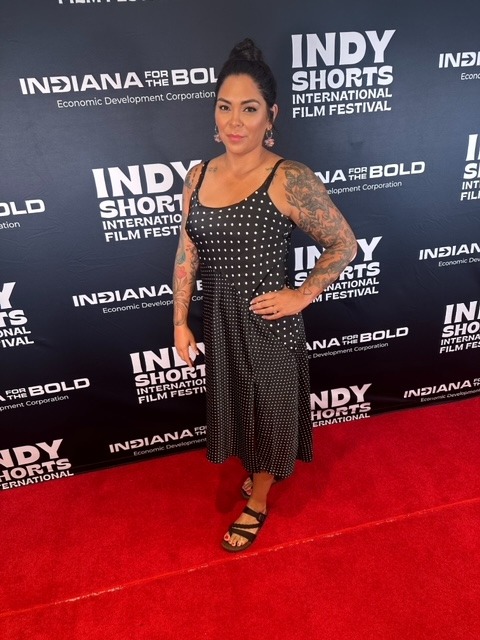
This month, we visited with Jen Murphy, an enrolled member of the Chippewa-Cree tribe from Rocky Boy. Known by her Indian name, Sweetgrass Lodge, Jen is a dedicated photographer and advocate for raising awareness about the crisis of Missing and Murdered Indigenous Women and People (MMIW/P). This ongoing tragedy refers to the disproportionate rates of violence, abduction, and murder experienced by Indigenous women and people in the U.S. and Canada. Through Jen’s work as a photographer, author, filmmaker, and advocate, she uses her talents to educate and inspire action within Native communities and beyond.
Please start with your background, tribe, where you grew up, family, schools attended, what you are currently doing now, etc.
I grew up in Havre, MT with a lot of family on our reservation in Rocky Boy (Chippewa-Cree). I attended and graduated High School from Havre High School in 1999. I then attended Montana State University Northern, where I graduated with a BA in Community Service/Communication. I am currently enrolled and am attending Montana State University – Bozeman, working on my Graduate Certificate in Native American Studies. I have worked as a Juvenile Detention Officer, a Child Protection Specialist, A Felony Parole Officer, a Tribal Liaison and an Executive Producer. Currently, I am an Executive Producer, children’s book author, an Associate for AMBER Alert in Indian Country, and a Tribal Liaison.
Could you share the moment or experience that inspired you to use photography as a tool for raising awareness about the Missing and Murdered Indigenous Women (MMIW) issue?

On June 16, 2018, Jermain Charlo went missing out of Missoula, MT. She was an enrolled tribal member. Living in Missoula at the time, I watched as the case unfolded and all of the errors and lack of response that happened. I wanted to do something to bring awareness to this issue and I always loved to take pictures. Photography has the unique ability to say a million things without saying a word. It is a medium you can look at and FEEL what is being said.
Your work spans different mediums, from photography to film. How do you decide which medium best conveys the message you want to share about MMIW?
Photography has always been my chosen medium. Just recently, I was introduced to film and what a great way to tell a story; our people have conveyed storytelling since the beginning of time and this is just another way to get the awareness out.
You recently authored a children’s book on MMIW. How do you approach the challenge of introducing such a sensitive issue to young readers?
As I have been doing this awareness work, I noticed a huge gap and that was in reaching our youth. My children’s book titled, “More Like Her,” is a simple book that allows families or educators to start introducing this topic to our children. You have the ability to help them understand the issue in a non-threatening way and begin this conversation, hopefully bringing awareness to them and hopefully make them aware that this does happen to our people.
Photography has the unique ability to say a million things without saying a word. It is a medium you can look at and FEEL what is being said.

What has the response been like to your short film, Not Afraid, as it travels through film festivals? Have any moments of feedback particularly stood out to you?
The responses have been really good. What stands out to me is that, still, after all of these years, people are stunned that this is happening to our people. Many still do not know that this is an issue, still today. It has been amazing to use this platform to help educate people on the topic.
Could you tell us more about the domestic violence Fatality Review commissions you’re involved with? What impact do these commissions have on legislative changes for Native communities?
The Domestic Violence Fatality Review Commissions have two teams, the State Team and the Native American Team. I am appointed by the Montana Attorney General to sit on both teams. This team is a multidisciplinary team of law enforcement, community members, judges, victim advocates, ect. and we look at trends of domestic violence homicides and make recommendations for legislative changes. These commissions when dealing with our communities in general, help us understand where victims are missed and what gaps need to be filled and paid attention too.
When collaborating with families affected by MMIW, what is the most important message you hope to convey through your work?
When working with families affected by MMIW/P, the most important message that I hope to convey is the power of being WITH them. That they are not alone, they are seen and their loved one deserved better.

How do you believe educating the general public on the history of MMIW can contribute to finding solutions to the crisis?
By bringing the right people to the table. It brings awareness to this crisis. I always say, you don’t know what you don’t know, until you know it. But, once you do, you should do better.
What has been the most challenging aspect of your work advocating for MMIW, and how do you stay motivated despite those challenges?
The most challenging thing about working as an advocate for MMIW is that I am not always going to please everyone. What I say to that is, I am doing what I believe that Creator has called me to do. I show up everyday with a warrior spirit and pray about everything I do. I talk with elders, I am open to feedback and I never pretend to be an expert at any of this. What I do is done with humility and a good heart.
I show up every day with a warrior spirit and pray about everything I do. I talk with elders, I am open to feedback, and I never pretend to be an expert at any of this.

What are your hopes for the future of MMIW awareness, especially with the next generation, through efforts like your children’s book?
My hope is that by bringing awareness, the public will start to understand that our people are not asking for special treatment. We are asking for the same treatment. We should be looked for the same, and our perpetrators should be punished the same way, etc. I hope that I inspire our youth to be a loud voice surrounding this issue. I pray that our youth find their voice, be a roaring lion on this issue, and stand up for what is right, even if their voice shakes.
If you could change one thing about the way society addresses domestic violence and MMIW today, what would it be and why?
Believing victims and their families. If we took victims and their families seriously from day one, I truly believe this would affect how things are done.
For more information about Jen’s work, visit www.mmiwproject.org or contact TveraaPhotoMT@gmail.com.

